mysql-DuplicateUpdate和java的threadpool的"死锁"

大家千万不要被文章的标题给迷惑了,他两在本篇文章是没有关系的, 今天给大家讲讲最近2个有意思的issue,分享一下我学到的
- mysql DuplicateUpdate的用法要注意的点
- java的threadpool使用不当会造成“死锁”问题
mysql DuplicateUpdate的用法要注意的点
有个issue说遇到了一个这样的问题, 
这个朋友使用我开源的job调度框架 https://github.com/yuzd/Hangfire.HttpJob
存储用的是mysql,采用的实现是 https://github.com/arnoldasgudas/Hangfire.MySqlStorage
set表的id是自增主键,正常理解 都是慢慢自增上去的,但是发现是大幅度跳跃式的自增, 真相是什么?
首先针对这个问题,首先我们搞清楚在hangfire中和storage相关的部分如下
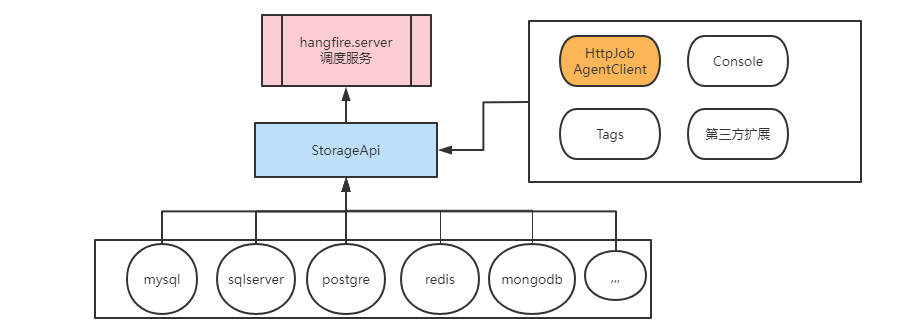 image
image
- hangfire server调度依赖storage
- storage抽象出来一层api(解耦)
- 第三方扩展(不关心具体的storage实现)
- 不同的storage具体实现(比如mysql,sqlserver等)
Hangfire.Httpjob其实只是依赖了storage api那一层,也没有能力去直接写sql去执行, 只能用api去操作hangfire的那几张表(比如set表)
那么问题肯定不是在扩展层,而是得去看看mysqlstorage的实现源码,针对set表的处理逻辑
public override void AddToSet(string key, string value, double score)
{
Logger.TraceFormat("AddToSet key={0} value={1}", key, value);
AcquireSetLock();
QueueCommand(x => x.Execute(
$"INSERT INTO `{_storageOptions.TablesPrefix}Set` (`Key`, `Value`, `Score`) " +
"VALUES (@Key, @Value, @Score) " +
"ON DUPLICATE KEY UPDATE `Score` = @Score",
new { key, value, score }));
}这里是用了ON DUPLICATE KEY UPDATE 的语句
这个语法是在mysql 4.1(2005)引入的,意思是 insert的时候遇到主键已存在 就执行后面 的update
但是就是这个功能 会造成自增主键成跳跃式增长,增长跨度和SQL的执行次数成正比
根据朋友提供的截图
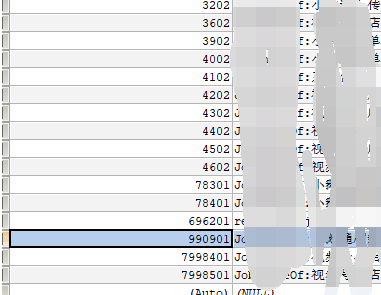 image
image
虽说是会跳跃,但是这个增长也太夸张了
打上断点调试发现
是hangfire server 不断的在调用,目的是把下一次执行时间(秒级别的时间戳)写到set表中
 image
image 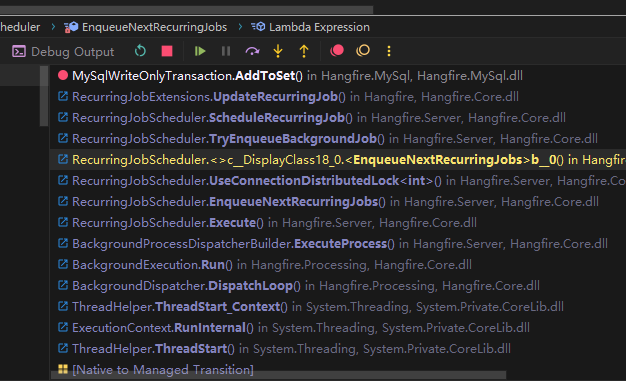 image
image 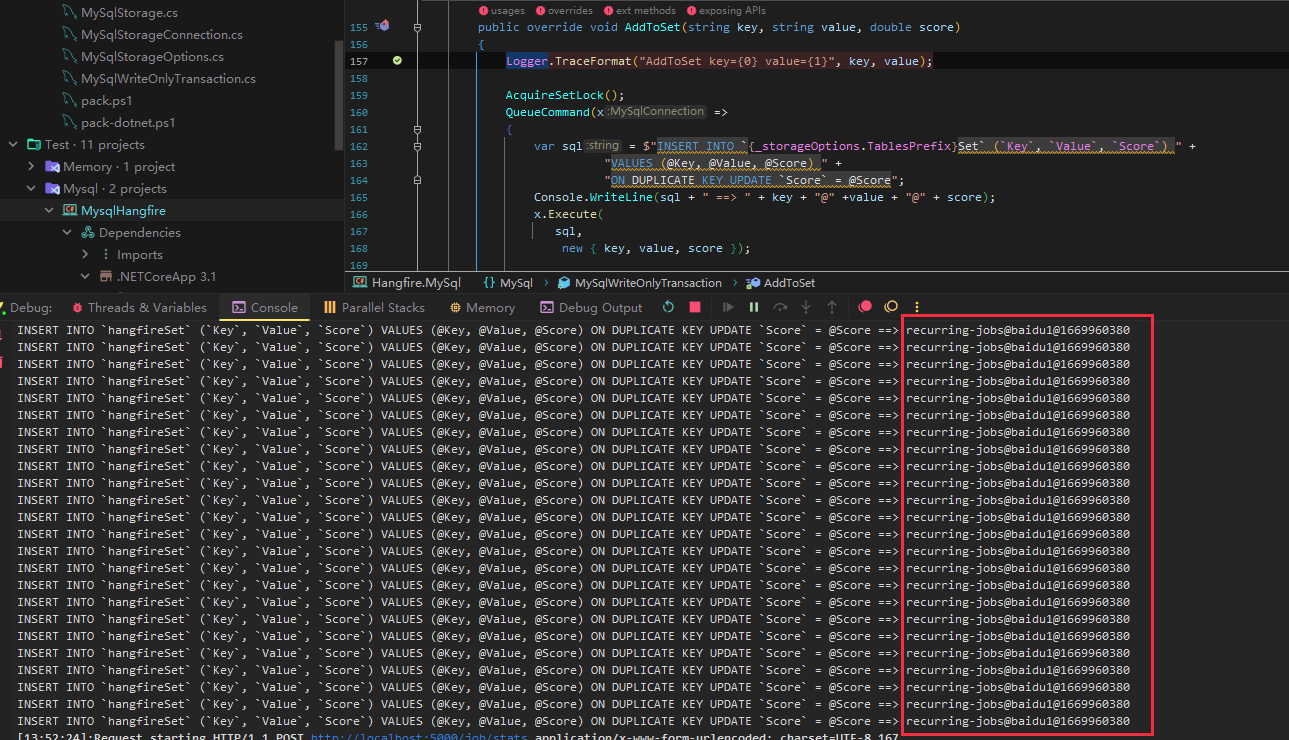 image
image
打上日志可以看到有非常多相同值的调用,这仅仅是一个job,这个自增速度得再乘以job的个数,难怪了
既然找到原因了,就提个PR 修改下
public override void AddToSet(string key, string value, double score)
{
Logger.TraceFormat("AddToSet key={0} value={1}", key, value);
AcquireSetLock();
QueueCommand(x =>
{
var sql = "";
if (key == "recurring-jobs") // 只发现这个key存在这个问题
{
// key+value是uniq 改成先update 如果没有成功 再insert
sql = $"UPDATE `{_storageOptions.TablesPrefix}Set` set `Score` = @score where `Key` = @key and `Value` = @value";
var updateRt = x.Execute(sql, new { score = score, key = key, value = value });
if (updateRt < 1)
{
sql = $"INSERT INTO `{_storageOptions.TablesPrefix}Set` (`Key`, `Value`, `Score`) " +
"VALUES (@Key, @Value, @Score) ";
x.Execute(
sql,
new { key, value, score });
}
}
else
{
sql = $"INSERT INTO `{_storageOptions.TablesPrefix}Set` (`Key`, `Value`, `Score`) " +
"VALUES (@Key, @Value, @Score) " +
"ON DUPLICATE KEY UPDATE `Score` = @Score";
x.Execute(
sql,
new { key, value, score });
}
//Console.WriteLine(sql + " ==> " + key + "@" + value + "@" + score);
});
}改完之后测试,id自增一切正常:
 image
image
注意上面演示的mysql存储是用的官方推荐的,
但是但是建议使用mysql作为存储的使用
https://github.com/MiloszKrajewski/Hangfire.Storage.MySql
官方推荐的版本有死锁的bug,有主键自增膨胀(归根到底还是没有控制好锁) 参考issue:
- https://github.com/arnoldasgudas/Hangfire.MySqlStorage/issues/63
- https://github.com/arnoldasgudas/Hangfire.MySqlStorage/pull/97
java的threadpool使用不当会造成“死锁”问题
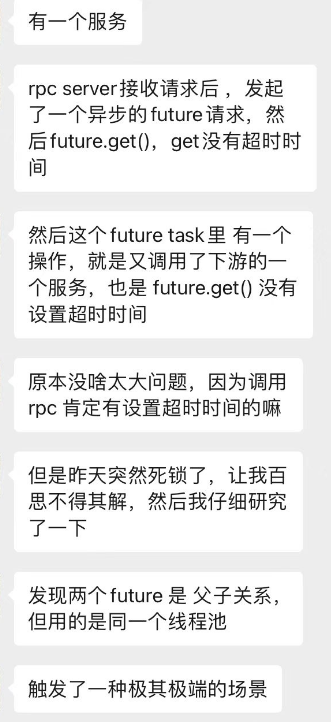 image
image
这个原因先说出来: threadpool的线程被占用完后,再来的task会往queue里面丢,如果这个时候在这个pool的线程里面 future.get()的话会导致task runner(执行器)被堵住,没人从队列里面取任务了~
(简单来说就是 线程在wait future返回,而这个future在queue里面苦苦等待新释放的线程去执行,就像死锁一样,我在等你的结果,而结果在等待着被执行)
好家伙,这个场景有点熟悉,因为我在项目中也用过Future.get()// 虽说有设置timeout
但是这个问题的重要一点是,这种花式“死锁” jvm是检测不出来的,下面有测试
模拟一下这个场景:
我搞了2个线程池,分别是nio线程池和业务线程池,模拟并发20个请求, 注意看process2方法里的注释,如果去掉那里的代码的话 就不会有这个死锁问题
/**
* @author yuzd
*/
public class PoolTest {
// 模拟nio线程池
static ThreadPoolExecutor nioExecutor = new ThreadPoolExecutor(20, 20, 60, TimeUnit.SECONDS, new LinkedBlockingQueue<>(100),
new CustomerNamedThreadFactory("nio", false),
new ThreadPoolExecutor.AbortPolicy());
// 业务线程池
static ThreadPoolExecutor buExecutor = new ThreadPoolExecutor(20, 20, 60, TimeUnit.SECONDS, new LinkedBlockingQueue<>(100),
new CustomerNamedThreadFactory("bu", true),
new ThreadPoolExecutor.AbortPolicy());
public static void main(String[] args) {
// 模拟是http请求并发20个
IntStream.rangeClosed(1, 20).parallel().forEach((index) -> {
// 交给nio线程池处理
nioExecutor.execute(() -> {
try {
httpHandler(index);
} catch (Exception e) {
e.printStackTrace();
}
});
});
}
static void httpHandler(int index) throws ExecutionException, InterruptedException {
System.out.println(Thread.currentThread().getName() + " request index :" + index + " staring");
// 交给业务线程池处理
Future<String> parentFuture = buExecutor.submit(() -> process1(index));
String p1Rt = parentFuture.get(); // nio线程在wait
System.out.println(Thread.currentThread().getName() + " request index :" + p1Rt + " ending");
}
// future1
static String process1(int index) throws ExecutionException, InterruptedException {
System.out.println( Thread.currentThread().getName() + " process1 index :" + index + " staring");
Future<String> childFuture = buExecutor.submit(() -> process2(index));
String p2Rt = childFuture.get(); // 这里是bu线程在wait 这里会发生死锁
System.out.println(Thread.currentThread().getName() + " process1 index :" + index + " ending");
return p2Rt;
}
// future2
static String process2(int index) throws InterruptedException, ExecutionException {
System.out.println(Thread.currentThread().getName() + " process2 index :" + index + " staring");
// 加上就会死锁
// 只要不一下子产生足够数量的task(把core全部占掉)就不会死锁 加了这里就会把core全部占据 导致task进入到queue,core线程在wait future.get 无法被释放, 而queue的任务在等待它释放产生新的线程
Future<String> submit = buExecutor.submit(() -> {
try {
Thread.sleep(1000);
return String.valueOf(index);
} catch (InterruptedException e) {
throw new RuntimeException(e);
}
});
submit.get();
System.out.println(Thread.currentThread().getName() + " process2 index :" + index + " ending");
return String.valueOf(index);
}
}用visualvm分析线程dump,很难直接发现有异常,异步的很难检测,排查起来比较复杂,只看到是在wait
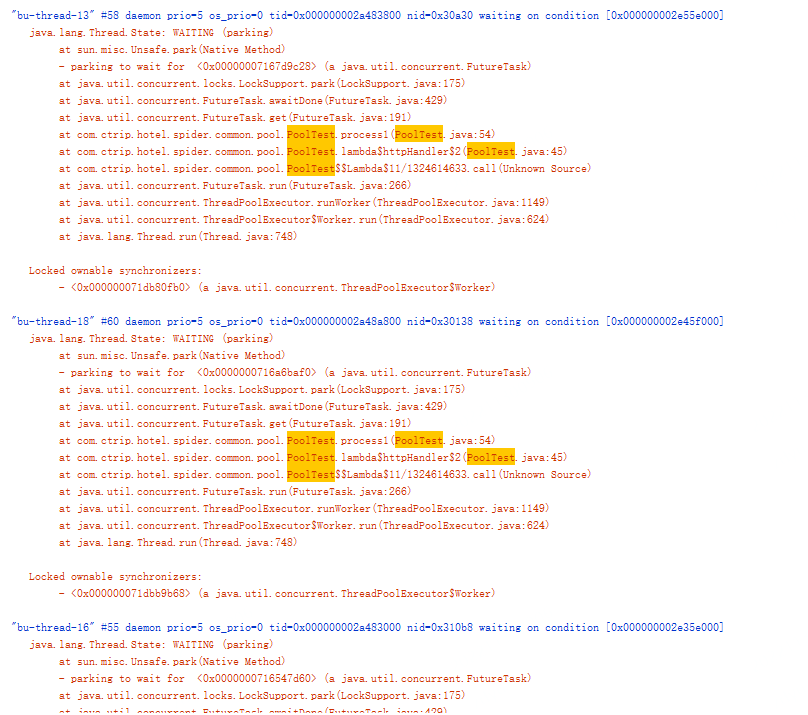 image
image
用jstack没有发现deadlock
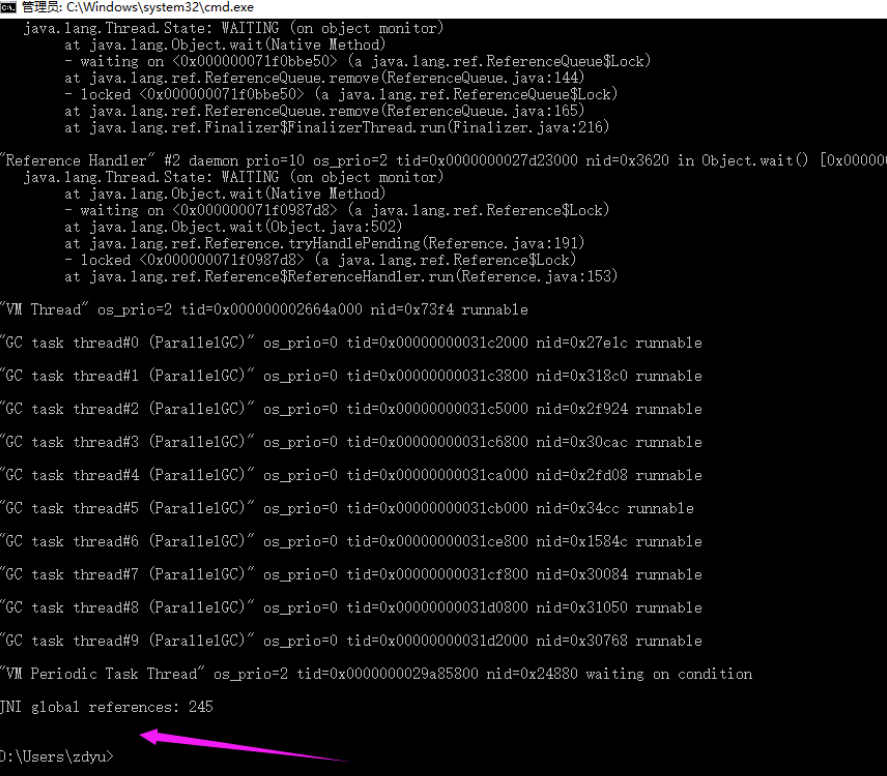 image
image
在实际项目中我也看到过一个项目中共用一个线程池,线程池被封装成一个util方法,要执行异步的都用它,这个场景尤其要注意这个场景,也建议大家用带有超时的方式 Future.get(xxxx)


如果您觉得阅读本文对您有帮助,请点一下“推荐”按钮,您的“推荐”将是我最大的写作动力!欢迎各位转载,转载文章之后须在文章页面明显位置给出作者和原文连接,谢谢。



【推荐】国内首个AI IDE,深度理解中文开发场景,立即下载体验Trae
【推荐】编程新体验,更懂你的AI,立即体验豆包MarsCode编程助手
【推荐】抖音旗下AI助手豆包,你的智能百科全书,全免费不限次数
【推荐】轻量又高性能的 SSH 工具 IShell:AI 加持,快人一步
· 阿里最新开源QwQ-32B,效果媲美deepseek-r1满血版,部署成本又又又降低了!
· 单线程的Redis速度为什么快?
· SQL Server 2025 AI相关能力初探
· 展开说说关于C#中ORM框架的用法!
· AI编程工具终极对决:字节Trae VS Cursor,谁才是开发者新宠?